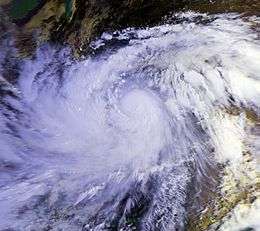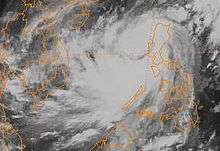Typhoon Ruby (1988)
| Typhoon (JMA scale) | |
|---|---|
| Category 4 (Saffir–Simpson scale) | |
 Typhoon Ruby near peak intensity | |
| Formed | October 20, 1988 |
| Dissipated | October 28, 1988 |
| Highest winds |
10-minute sustained: 140 km/h (85 mph) 1-minute sustained: 230 km/h (145 mph) |
| Lowest pressure | 950 hPa (mbar); 28.05 inHg |
| Fatalities | 300+ total |
| Damage | $1.3 billion (1988 USD) |
| Areas affected | Guam, Marianas Islands, Philippines, China (especially Fujian and Hainan) |
| Part of the 1988 Pacific typhoon season | |
Typhoon Ruby, known in the Philippines as Typhoon Unsang, was a Category 4 typhoon that caused over 300 deaths and billions of dollars in damages. It was the deadliest and costliest storm of the season. The tenth typhoon of the 1988 Pacific typhoon season, Ruby formed from an area of low pressure east of the Philippines on October 20. It intensified to a 230 km/h (145 mph) typhoon while approaching central Luzon. It hit the island on the October 24, and rapidly weakened to a minimal typhoon over the island. Ruby, with its disrupted circulation, remained weak over the South China Sea, and land interaction with Vietnam caused it to dissipate on October 28.
Ruby caused over 300 fatalities, with widespread flooding and damage over its track. Ruby brought heavy rains and a 3.7 meter (12 feet) storm surge to Guam and the Marianas Islands. On Luzon, the storm's 220 km/h (140 mph) winds caused tremendous damage to the town of Siniloan. In the Polillo Islands, east of Manila, Ruby spawned rare tornadoes that leveled homes. In the northern part of the Philippines, many fishing boats were wrecked by 30–40 foot waves, and 32 more people drowned.[1] Damage in the Philippines totaled 5.64 billion Philippine pesos (1989 pesos).[2]
The passenger ferry Doña Marilyn was in the Visayan Sea when the storm struck the vessel. The ferry was not designed for deep water, and the open decks let water into the interior of the ship. The storm caused the ferry to pitch to the starboard until one of the decks was below the water, causing the ship to fill up rapidly. The passengers and crew tried to save the ship, but to no avail. The Doña Marilyn sank stern first, taking 389 people with it. Only 147 people survived by clinging to life rafts. Typhoon Ruby was the twelfth most intense tropical cyclone in terms of wind speed to affect the Bicol Region of the nation.[3]
Meteorological history

The final of four typhoons to develop during October 1988, Typhoon Ruby originated from an area of disturbed weather formed on October 20;[4] consequently, both the Joint Typhoon Warning Center (JTWC) and Japan Meteorological Agency (JMA) started tracking the system at 18:00 UTC.[4][5][nb 1] Following an increase in convection, a Tropical Cyclone Formation Alert (TCFA) was issued by the JTWC early on October 21.[4] At noon, the JTWC was first classified as a tropical depression while the JMA upgraded the disturbance into a tropical storm.[7][nb 2] At the time of classification, the cyclone was situated about 1,760 km (1,095 mi) east-southeast of Manila on October 21 and moved southwestwards at first. Early on October 22, the depression rapidly intensified into a tropical storm, and was given the name "Ruby".[9]
Initially, the storm moved southeastward,[9] before taking on a westward course typical of a "straight runner".[4] During that afternoon, the JMA reported that Ruby strengthened into a severe tropical storm.[5] Both agencies estimate that Ruby attained typhoon status on October 23[7] Despite developing a small pinhole eye,[9] Ruby only strengthened slightly over the next 24 hours.[5] However, estimates from the JTWC suggests that Nina steadily strengthened over that period,[7] ultimately attaining peak intensity with winds of strong 230 km/h (145 mph) typhoon, and a pressure of 950 mbar (hPa; 28.05 inHg).[9] Meanwhile, the JMA estimated maximum intensity of 85 mph (135 km/h) and the same pressure.[5] While maintaining a small 30 km (19 mi) eye,[4] Ruby accelerated to a speed of about 27 km/h (17 mph) in its movement towards Luzon. It made landfall over central Luzon early on October 24,[9] while according to the JMA still at maximum intensity,[5] and entered the South China Sea the next morning.[9]
Based on JMA data, Ruby was believed to have maintained its intensity over land, although the JTWC noted that Ruby had weakened substantially over land.[7] During the evening of October 25, when it was about 350 kilometers (220 miles) west-northwest of Manila, Ruby weakened slightly and slowed down significantly, moving on an erratic track. It then took on a west-northwestward track at about 20 km/h (12 mph) later on October 26.[9] Around this time, the JMA downgraded Ruby into a severe tropical storm.[5] While moving in the general direction of Hainan,[4] the JTWC estimates that Ruby lost typhoon intensity on the morning of October 27.[7] Increased northeasterly wind shear took toll on the storm, resulting in continued weakening. That afternoon, Ruby struck the island of Hainan,[9] with according to the JMA, 60 mph (95 km/h) winds.[5] Land interaction with the mountains of the island accelerating the weakening trend, and after becoming devoid of deep convection, the JTWC ceased tracking Ruby late on October 28.[4] Eighteen hours later, the JMA followed suit.[5]
Impact

Philippines
Prior to the arrival of Ruby, storm warnings were issued in Manila, Visayas Islands, the northern coast of Mindanao and south to central portions of Luzon. Manila's international airport canceled more than 25 domestic flights on October 24. However, international flights operated normally.[10]
Ruby is the nineteenth typhoon to strike the nation of the 1988 season, and the twelfth most intense tropical cyclone in terms of windspeed to affect the Bicol Region.[3] Simultaneously, The system was also the most intense tropical cyclone to hit the main island of Luzon since Super Typhoon Patsy of the 1970 season.[11]
Ten people drowned on October 23 when a tornado triggered flash flooding in six villages near Cagayan De Oro, 800 km (500 mi) southeast of Manila. More than 20,000 people were left homeless by the typhoon. The flash flooding first took place on October 22. The tornado was spawned by Typhoon Pat, which struck the nation the same day.[10] Ruby also flattened homes, sank ships, blew buses and trucks off highways,[12] and destroyed coconut, rice, sugar and many other crops. More than 28,190 people were either left homeless or in evacuation centers in ten affected provinces.[13] Ruby also caused mudslides and tidal surges that left thousands more homeless and forced the cancellation of numerous schools. In Cagayan de Oro, the storm left seven dead. Six children drowned in flood waters and a pregnant woman was killed.[14]
The 2,855,000 kilogram (2,855 ton) passenger ferry MV Doña Marilyn sank during Ruby. It was last seen about 325 kilometers (200 miles) southeast of Manila. There were only fifteen confirmed survivors, as the storm abated. The passenger ferry had 518 passengers and crew members aboard. The ship had taken over the route of a sister vessel, the Dona Paz, which sank the previous December with a death toll of more than 1,700 (unofficial estimates put the death toll to more than 3,000).[15] A cargo ship picked up eight survivors from the Doña Marilyn; eleven other survivors were found on Maripipi Island and on another very small island, and four were found floating in the water.[16] Marikina City suffered from widespread flooding by heavy rains brought by Ruby, and many residents were stranded (many were found on their houses' rooftops and trees, and were later rescued by helicopters). Properties and businesses were flooded and roads were impassable to traffic. President Corazon Aquino declared six regions in Luzon, Visayas and northern Mindanao under a state of calamity.
Because of the death toll and extreme damages caused by the storm, PAGASA later retires the name Unsang and was replaced by Ulpiang and was first used in the 1996 season.
China
On the afternoon of October 27, Ruby struck the island of Hainan as a tropical storm, killing two people and causing about 133 million RMB of damage. Four other people were reported missing.[17] Ruby also caused heavy flooding on the island, and was one of the costliest flood events of 1988.[18] Ruby's flooding caused over $173 million in damages.[17]
Notes
- ↑ The Japan Meteorological Agency is the official Regional Specialized Meteorological Center for the western Pacific Ocean.[6]
- ↑ Wind estimates from the JMA and most other basins throughout the world are sustained over 10 minutes, while estimates from the United States-based Joint Typhoon Warning Center are sustained over 1 minute. 10‑minute winds are about 1.14 times the amount of 1‑minute winds.[8]
See also
References
- ↑ "Typhoon Ruby". Joint Typhoon Warning Center. Archived from the original on June 7, 2011.
- ↑ "Most Destructive Tropical Cyclones for Month of October (1948-2000)". Philippine Atmospheric Geophysical and Astronomical Services Administration. Archived from the original on May 11, 2004.
- 1 2 "29 MOST INTENSE TYPHOONS OF BICOL REGION, PHILIPPINES (1947 - 2006)". Typhoon 2000. 2004. Retrieved 2012-01-19.
- 1 2 3 4 5 6 7 Joint Typhoon Warning Center; Naval Pacific Meteorology and Oceanography Center (1989). Annual Tropical Cyclone Report: 1988 (PDF) (Report). United States Navy, United States Air Force. Retrieved August 12, 2016.
- 1 2 3 4 5 6 7 8 Japan Meteorological Agency (October 10, 1992). RSMC Best Track Data – 1980–1989 (.TXT) (Report). Retrieved August 12, 2016.
- ↑ "Annual Report on Activities of the RSMC Tokyo – Typhoon Center 2000" (PDF). Japan Meteorological Agency. February 2001. p. 3. Retrieved August 12, 2016.
- 1 2 3 4 5 Kenneth R. Knapp; Michael C. Kruk; David H. Levinson; Howard J. Diamond; Charles J. Neumann (2010). 1988 Ruby(1988295N10138). The International Best Track Archive for Climate Stewardship (IBTrACS): Unifying tropical cyclone best track data (Report). Bulletin of the American Meteorological Society. Retrieved August 12, 2016.
- ↑ Christopher W Landsea; Hurricane Research Division (April 26, 2004). "Subject: D4) What does "maximum sustained wind" mean? How does it relate to gusts in tropical cyclones?". Frequently Asked Questions:. National Oceanic and Atmospheric Administration's Atlantic Oceanographic and Meteorological Laboratory. Retrieved August 12, 2016.
- 1 2 3 4 5 6 7 8 Meteorological Results: 1988 (PDF) (Report). Hong Kong Royal Observatory. 1989. Retrieved August 12, 2015.
- 1 2 "Typhoon lashes the Philippines". The Gettysburg Times. October 24, 1988. Retrieved January 20, 2012.
- ↑ Lee Davis. Natural Disasters. Retrieved January 21, 2012.
- ↑ "Typhoon Ruby strikes the Philippines". The Los Angeles Times. September 9, 2016.
- ↑ "Typhoon slams into the Philippines". The Deseret News. October 24, 1988. Retrieved January 21, 2012.
- ↑ "Typhoon Ruby rips through the Philippines". Associated Press. October 24, 1988. Retrieved January 21, 2012.
- ↑ Seth Mydans (October 26, 1988). "Typhoon sinks passenger ferry". The New York Times.
- ↑ "15 ferry survivors found safe". The Milwaukee Journal. October 25, 1988. Retrieved January 21, 2012.
- 1 2 "Historical Information". Hong Kong Observatory. Retrieved 2012-1-21.
- ↑ "1988 Flood Archive" Dartmouth. Retrieved 2012-01-21.
External links
| Wikimedia Commons has media related to Typhoon Ruby (1988). |
